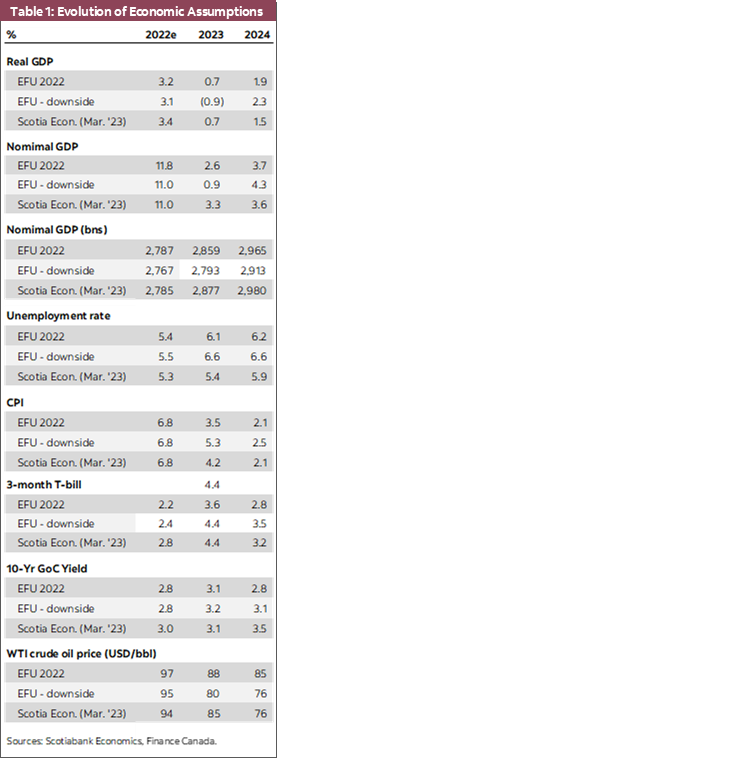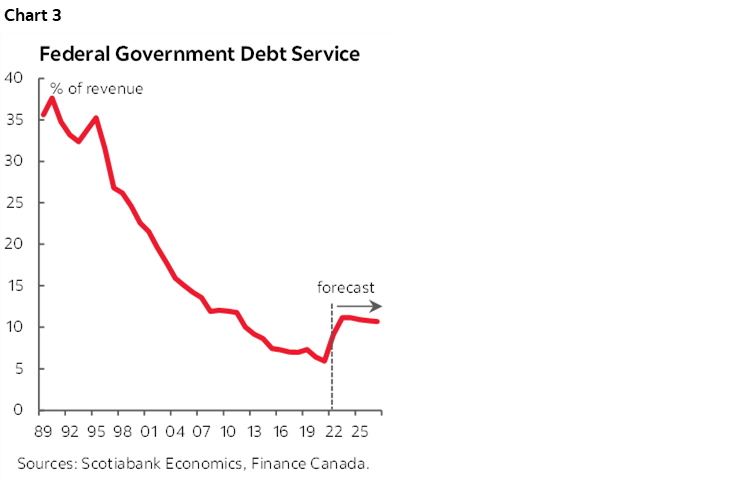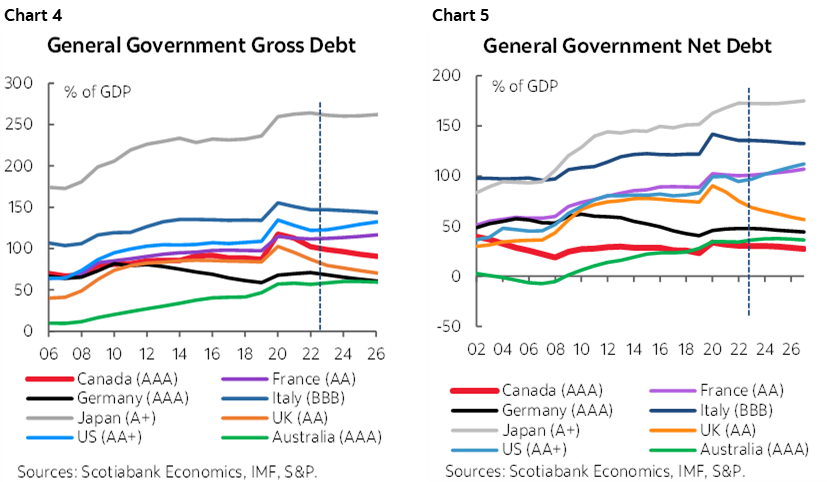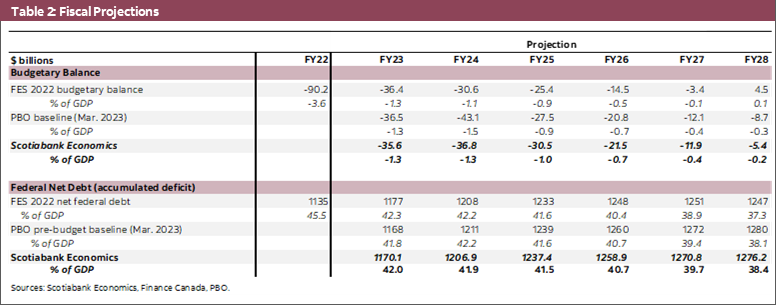CAUTION: SPEND BUMPS AHEAD
- Canadians will get a fresh look at the state of federal finances when Canadian Finance Minister Freeland tables Budget 2023 on March 28th.
- More spending has been well-channeled ahead of budget day with affordability, healthcare, and a clean economy expected to feature prominently.
- We wager a final price tag in the order of $50 bn (including $20 bn in earlier-announced healthcare lifts) in this budget. Revenue windfalls that marked earlier fiscal resets are not expected to provide much offset this time around, but—along with earlier provisions—would bring the net budgetary impact closer to $35 bn.
- The Minister has promised fiscal restraint, which likely means keeping fiscal metrics—deficit and debt paths as a share of the economy—trending downward over the medium term in the baseline. Our scenario walks this fine line, while still signalling ambition in the budget’s expected green centerpiece (charts 1 & 2).
- Ramped up investments towards Canada’s net-zero goals are warranted, and, effectively designed, could dually accelerate progress towards Canada’s domestic climate goals while also chipping away at its growing productivity gap.
- Otherwise, fiscal authorities could have reasonably sat this one out to reduce inflation, while readying their own playbooks should economic conditions deteriorate more than warranted. But that won’t happen.
- The slippery slope that Canada—and other countries—must navigate in sustaining necessary green investments across the economic cycle to avoid supersizing the whole spending budget. A couple billion should go back to being a big deal in federal fiscal finances, but it is still likely to be a rounding error in this budget.
- Nevertheless, the budget will be digested in a volatile market environment where exogenous factors are mostly carrying the day. Continued federal fiscal activism is largely anticipated and Canada’s relative debt advantage should still be intact when the dust settles.

THE CERTAINTY OF UNCERTAINTY
Canada’s federal Finance Minister will deliver another budget in an environment of elevated uncertainty and ever-evolving developments. Nominal output may look surprisingly similar to private sector expectations at the time of the Fall Economic Statement (FES) last November, but the underlying story looks quite different. Inflation has proven hotter and consequently interest rates higher than anticipated, more closely resembling the downside scenario painted last Fall. Incredibly tight labour markets and more general resilience in the real economy have largely offset those impacts and place output broadly in line with prior baseline expectations, at least so far (table 1).

Fresh risks loom on the horizon. Private sector economists’ forecasts that shape the baseline for the budget will be stale by publication time. These numbers would have been locked in weeks ago before recent financial market turbulence, which—at a minimum—is likely to modestly erode the outlook for US economic growth and consequently for Canada. Finance officials are likely rapidly reworking a downside scenario of persistent inflation, and now, with an added twist of elevated financial instability, tightened credit conditions, and an (even more) uncertain monetary policy response.
The case for coordinated fiscal policy is even stronger as complexities mount for central bankers. The Bank of Canada and its counterparts are carefully navigating a narrowing line between slowing growth ‘just enough’ to return price appreciation to target versus triggering a far sharper contraction amplified by financial market instability. With Canada’s economy in surplus territory and a host of previously-announced federal and newly-unveiled provincial measures hitting households in the coming quarters, fiscal authorities could reasonably sit this one out (ringfencing green investments) to reduce inflation, while readying their own playbooks should economic conditions deteriorate more than warranted.
POINTS FOR PREDICTABILITY
What the government should do versus what they will do are not likely the same thing. Priorities have been well-channeled ahead including affordability, healthcare, and the clean economy. The Finance Minister has gone further in explicitly indicating that additional, targeted supports are on the way in the budget.
Unlike the past several updates, this one likely provides little cover for new spending as fiscal windfalls are likely smaller and short-lived. There is still likely some steam left in revenue sources—particularly personal income tax receipts—that should deliver a little more fiscal space in the very near term (in the order of $5 bn in FY23), but clearly nowhere near the sums from past updates. Meanwhile outer-year finances face more headwinds. Our best guess is that a stronger handoff from this fiscal year would mostly offset waning fiscal drivers in outer years in a baseline scenario, while recognising a downside scenario likely deserves more weight in this budget.
While mostly conjecture, we wouldn’t be surprised to see gross new spending in the order of $50 bn over the budget’s planning horizon. Our assumptions are detailed in Box 1, but this would approximately comprise of $20 bn in previously-announced healthcare spending, a new “clean economy” package in the order of $22 bn, and a smaller catch-all category of other items—including a few frontloaded affordability-related ones—amounting to about $8 bn over five years (FY23–28). After netting out fiscal developments and an $8.5 bn provision in the fall update, such an illustrative spending profile would reflect a net $35 bn in additional budgetary pressures relative to the Fall update.
IN THE EYE OF THE BEHOLDER
The fiscal path would deteriorate modestly—but not substantially—relative to the Fall outlook under our scenario. It would add a tenth or two of a percentage point of GDP annually to the bottom line over the horizon. The deficit could hover around -1.3% of GDP this year and next before resuming its gradual decent towards balance, but the return to surplus projected last November would likely evaporate.
The primary balance (i.e., netting out debt charges) will likely shift into surplus territory next year and increasingly widen over the planning horizon, but this is not likely to assuage fiscal hawks. Elevated interest rates (against higher debt levels) are driving up debt servicing costs over the horizon. On balance, we see more upside risk to earlier interest rate assumptions (and current market pricing) which warrants caution even if debt servicing costs (relative to GDP or total revenues) still remain historically low (chart 3).

Fiscal restraint has once again been promised in this budget. Consistent with past practices, we interpret this to mean a downward-sloping debt trajectory over the medium term. Our illustrative profile modestly softens that slope with net federal debt likely holding around 42% of GDP through FY24 before gradually declining to about 38% by the end of the planning horizon. This should be enough to preserve Canada’s general government (federal and provincial) debt advantage when the IMF refreshes its comparative numbers next month (charts 4 & 5). It doesn’t provide much margin should economic conditions deteriorate substantially, but in that case all guardrails are gone anyway.

THE BENEFIT OF PERSPECTIVE
Markets will likely largely look through this budget. It will be absorbed in an environment of heightened volatility and risk aversion. This is shoring up demand for risk-free government securities (including Canadian treasuries), underpinned by markets (perhaps prematurely) pricing in interest rate cuts ahead. Modest and predictability persistent deficit spending expected in this budget would likely be swallowed up in an evolving reassessment of risk.
In calmer times and with the benefit of hindsight, the expected green investments may even (hopefully) be foundational. The sustainability of the government’s tax-and-spend approach depends on it—at least in economic terms—which ultimately requires growth. In political terms, it likely buys more time. With the balance of power sitting with the NDP in this minority government, they may be the only party with a keen interest in status quo.

BOX 1: GETTING TO THE BOTTOM LINE (AND THE BACK OF THE BUDGET)
CHAPTER ONE: AFFORDABILITY
Look for a few new, targeted measures folded into an exhaustive list of federal measures already in the works. Just to name a few already in the pipeline: advance payments of the Canada Worker Benefit will start flowing this summer (with an estimated incremental $2.4 k annual for a two-person low-income household); the roll-out of the universal childcare program should yield average annual savings in the order of $6–10 k (Ontario) for families with children in daycare; the one-time $500 top-up to the Canada Housing Benefit (CHB) to low-income renters recently launched; and the 6-mos doubling of the GST credit that is in effect through Spring. The list of provincial measures is even more expansive with affordability measures approaching $10 bn since the last budget cycle even before accounting for a growing list of new commitments in recently-tabled budgets. Nevertheless, more has been promised and the most likely candidate is an extension of the GST rebate (costed at $2.5 bn in the last round) and/or possibly another CHB top-up (at $1 bn).
CHAPTER TWO: HEALTHCARE
Look for a relatively contained set of previously-announced measures in this space. In early February, the federal government announced it would increase health funding to provinces and territories by $196.1 billion over 10 years, including $46.2 billion in new funding. Incremental funding over the budget horizon is likely much smaller—in the order of $20 bn through FY28—given the Canada Health Transfer would have risen in line with nominal growth (and hot) inflation. The budget may also announce extensions to dental care, but Budget 2022 had allocated $5.3 bn towards this priority with only $900 mn allocated last Fall. The NDP won’t likely get substantive down payments on universal pharmacare, but $1.5 bn was pledged towards access to drugs for rare diseases in recent days.
CHAPTER THREE: A CLEAN ECONOMY
Look for a number that signals ambition. The Finance Minister has indicated Canada needs to level the playing field with the US Inflation Reduction Act (IRA), which is expected to invest about USD400 bn over ten years in energy security and climate change, mostly delivered through corporate tax incentives and subsidies. Simply scaling this to Canada’s economy could equate to $50 bn (over 10 years). Keep in mind, the federal government has already announced $37 bn (over 5-year planning horizons) since 2021 (i.e., $18 bn in Budget 2021, $12 bn in Budget 2022, $7 bn in the 2022 Fall update), while also leaning more heavily on carbon taxes to do some of the heavy lifting. Based on pure conjecture, a package in the range of $20–25 bn would not be out of line with earlier pledges, would signal ambition, and could still be accommodated within the fiscal framework without setting off alarms (if well-designed).
Where they would spend this is a tricker question. The policy and regulatory landscapes are fundamentally different in Canada and the US, largely negating a policy-matching approach. Canada has also already tabled a number of tools: various investment tax credits (clean technology, clean hydrogen, CCUS), the Canada Growth Fund, the Net Zero Accelerator, while also tapping into the new Canada Innovation Corporation and the Canada Infrastructure Bank, to name a few. Look for more carrot-based approaches targeting the clean manufacturing sector where, so far, the government’s approach of targeted and direct support in areas like EV supply chains has shown relative promise, but needs scale-up. Look for details on the earlier-announced tax credit for clean energy, and possible complimentary measures to capture public sector and crown corp green gridding efforts. Possibly look for ways the federal government uses its leverage (and its balance sheet) to incentivize lower-level government procurement strategies in green infrastructure. Look (hope) for less, not more, complexity under a unifying strategy.
To be clear, this is not even close to the scale likely needed on a path to net-zero. Budget 2022 pegged total incremental investment needs (public and private) in the order of $100 bn by 2050 on top on the (then) $15–25 bn current outlay. This would roughly translate into a public incremental share of about $30–40 bn annually by 2050. To pave the way for further investments at scale, the federal government likely needs some early signs that current investments are working, that they are crowding in private capital, and that the government is able operate a two-track fiscal path, namely it has the discipline to calibrate current expenditures to economic conditions, while aggressively ramping up green investments to enhance longer term competitiveness in a low carbon world.
DISCLAIMER
This report has been prepared by Scotiabank Economics as a resource for the clients of Scotiabank. Opinions, estimates and projections contained herein are our own as of the date hereof and are subject to change without notice. The information and opinions contained herein have been compiled or arrived at from sources believed reliable but no representation or warranty, express or implied, is made as to their accuracy or completeness. Neither Scotiabank nor any of its officers, directors, partners, employees or affiliates accepts any liability whatsoever for any direct or consequential loss arising from any use of this report or its contents.
These reports are provided to you for informational purposes only. This report is not, and is not constructed as, an offer to sell or solicitation of any offer to buy any financial instrument, nor shall this report be construed as an opinion as to whether you should enter into any swap or trading strategy involving a swap or any other transaction. The information contained in this report is not intended to be, and does not constitute, a recommendation of a swap or trading strategy involving a swap within the meaning of U.S. Commodity Futures Trading Commission Regulation 23.434 and Appendix A thereto. This material is not intended to be individually tailored to your needs or characteristics and should not be viewed as a “call to action” or suggestion that you enter into a swap or trading strategy involving a swap or any other transaction. Scotiabank may engage in transactions in a manner inconsistent with the views discussed this report and may have positions, or be in the process of acquiring or disposing of positions, referred to in this report.
Scotiabank, its affiliates and any of their respective officers, directors and employees may from time to time take positions in currencies, act as managers, co-managers or underwriters of a public offering or act as principals or agents, deal in, own or act as market makers or advisors, brokers or commercial and/or investment bankers in relation to securities or related derivatives. As a result of these actions, Scotiabank may receive remuneration. All Scotiabank products and services are subject to the terms of applicable agreements and local regulations. Officers, directors and employees of Scotiabank and its affiliates may serve as directors of corporations.
Any securities discussed in this report may not be suitable for all investors. Scotiabank recommends that investors independently evaluate any issuer and security discussed in this report, and consult with any advisors they deem necessary prior to making any investment.
This report and all information, opinions and conclusions contained in it are protected by copyright. This information may not be reproduced without the prior express written consent of Scotiabank.
™ Trademark of The Bank of Nova Scotia. Used under license, where applicable.
Scotiabank, together with “Global Banking and Markets”, is a marketing name for the global corporate and investment banking and capital markets businesses of The Bank of Nova Scotia and certain of its affiliates in the countries where they operate, including; Scotiabank Europe plc; Scotiabank (Ireland) Designated Activity Company; Scotiabank Inverlat S.A., Institución de Banca Múltiple, Grupo Financiero Scotiabank Inverlat, Scotia Inverlat Casa de Bolsa, S.A. de C.V., Grupo Financiero Scotiabank Inverlat, Scotia Inverlat Derivados S.A. de C.V. – all members of the Scotiabank group and authorized users of the Scotiabank mark. The Bank of Nova Scotia is incorporated in Canada with limited liability and is authorised and regulated by the Office of the Superintendent of Financial Institutions Canada. The Bank of Nova Scotia is authorized by the UK Prudential Regulation Authority and is subject to regulation by the UK Financial Conduct Authority and limited regulation by the UK Prudential Regulation Authority. Details about the extent of The Bank of Nova Scotia's regulation by the UK Prudential Regulation Authority are available from us on request. Scotiabank Europe plc is authorized by the UK Prudential Regulation Authority and regulated by the UK Financial Conduct Authority and the UK Prudential Regulation Authority.
Scotiabank Inverlat, S.A., Scotia Inverlat Casa de Bolsa, S.A. de C.V, Grupo Financiero Scotiabank Inverlat, and Scotia Inverlat Derivados, S.A. de C.V., are each authorized and regulated by the Mexican financial authorities.
Not all products and services are offered in all jurisdictions. Services described are available in jurisdictions where permitted by law.

